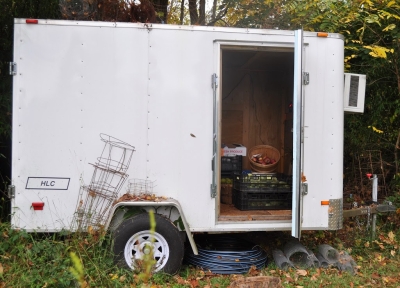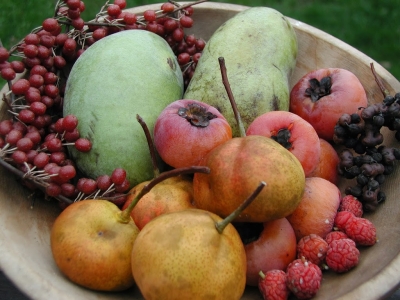—————————————–
Growing fruits is one of my specialties but, sad to admit, I may be the worst apple grower I know. What’s worse is all the time and effort I put into growing my apples, even way before they begin to fruit.
Mine are all super-dwarf trees, planted because these small trees yield more from a given land area than large trees and they eliminate the need for ladders. Usually, dwarf trees are made by grafting the
desired variety onto special dwarfing rootstocks. Mine are M.27, M.9, and Bud.9. But dwarfing rootstocks have weak root systems that barely support the trees and cannot forage far for nutrients and water. So the trees need staking and the best of soil conditions.
My super-dwarfs are special. They are interstem trees, each of which I made by grafting a desired variety onto a foot-long stem from a dwarfing rootstock variety (the stem piece itself can confer dwarfing) which, in turn, I grafted atop a seedling rootstock. The roots, then, are of seedling apples (made by planting any apple seed). Seedling apple roots forage well and make sturdy trees.
Despite the robust root systems, I still provided excellent soil conditions. The trees grow in a mulched strip 8 feet wide and drip irrigation automatically ministers to their water needs.
With all this, the trees began the season well, a few sprays and some traps keeping insects and diseases at bay followed by careful thinning out of the swelling fruit so that the trees’ energies could be channeled into fewer and, hence, better fruits. Beautiful fruits hung from the branches going into early summer. And then, the bane of my apples struck. Summer diseases, such as white rot and black rot, started to erode away fruits with telltale rotted areas. By August, whatever fruits were still on the plants were mostly rotting.
Why my repeated failures with apples? Everyone else seems to have decent enough apple crops this year, although one’s sense of decency for their own backyard fruits is sometimes shaded through rose-colored lenses. How about blaming the weather, the wet June? No, everybody around here had it. I blame my site: It’s backed by 6000 acres of woods (not mine) in which lurks plum curculio and other pests. Also, all summer, cooler air collects in this low-lying valley; moisture condensing out of cooling air promotes pest problems.
Moving to an upland site, ideally on sloping land bathed in full sun, would go far to spelling apple success for me. Still, pests make apples among the most challenging of fruits to grow almost everywhere east of the Rocky Mountains.
————————————————
By right, I should just abandon apple growing. But I don’t.
Perhaps it is the eternal optimism of a fruit grower. Next year . . . I’ll prune more carefully trying to rid my trees of overwintering innoculum for summer diseases. I’ll try out a new, organic fungicide, such as Regalia, safe to use and extracted from — of all things — that fierce weed Japanese knotweed. Perhaps I’ll be lucky.At the very least, growing apples gives me some failures to write about.
The other reason I persist is for taste. There are over 5,000 varieties of apples and knowing how to graft makes it relatively easy to create a tree of virtually any of them. Or to lop off the top of what was
 |
| My Hudson’s Golden Gem this year |
thought to have been a promising tree to quickly create a tree of a new variety. Buying apples limits you to the dozen or so varieties selected, in large part, for good shipping, good looks, and other commercial qualities.
Which brings me to Hudson’s Golden Gem, a golden apple, not yellow, like Golden Delicious, but truly golden, its russeted skin bouncing off light as if coated with flecks of gold metal. Inside, the flesh has a coarse, chewy texture and sweet, rich flavor that hints of pears and walnut. This variety seems to bear a bit more reliably than many others.
Hudson’s Golden Gem is one of a dozen varieties that I grow for their outstanding flavor — when I get fruit.
————————————————
When people talk of planting “fruit,” they usually mean planting apples. But apples are not the only fruit.
Notwithstanding my poor luck with apples, I am inundated with other fruits. Right now, baskets are
overflowing with the likes of American persimmons, pawpaws, and kiwiberries, and there are plenty of grape bunches and figs to be plucked and pears waiting to be ripened and eaten.
People often ask me what I do with all the fruit that I grow. I eat it! Not right now, of course, so much of it has to be stored.
No refrigerator could accommodate all my fruit, so enter CoolBot (http://www.storeitcold.com). CoolBot makes it possible to use a room air conditioner to cool an insulated storage room to the near-freezing temperatures suitable for storing fruits.
This electronic device, when paired to an air conditioner, “fools” the air conditioner into thinking that it has not yet reached 60°, which is the
lowest temperature those units normally wants to go. All you do is set the CoolBot for the temperature to which you want the room to cool. CoolBot also uses less energy than a standard, walk-in, cooler compressor.
My storage room consists of a trailer the inside panelling of which I removed, added foam insulation, and replaced. Right now it’s stacked high with boxes of fruit.
Perhaps one year, some of those boxes will be filled with apples.
————————————————————–






